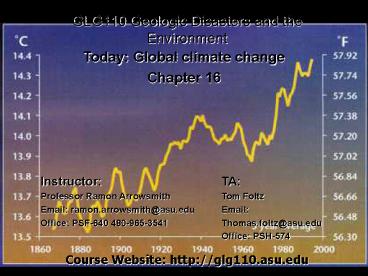GLG110 Geologic Disasters and the Environment - PowerPoint PPT Presentation
1 / 37
Title:
GLG110 Geologic Disasters and the Environment
Description:
... influence of these cycles on insolation (INcident SOLar radiATION) at different ... the Northern Hemisphere, peak summer insolation occurred about 9,000 years ago ... – PowerPoint PPT presentation
Number of Views:184
Avg rating:3.0/5.0
Title: GLG110 Geologic Disasters and the Environment
1
GLG110 Geologic Disasters and the Environment
Today Global climate change Chapter 16
Instructor Professor Ramon Arrowsmith Email
ramon.arrowsmith_at_asu.edu Office PSF-640
480-965-3541
TA Tom Foltz Email Thomas.foltz_at_asu.edu Office
PSH-574
Course Website http//glg110.asu.edu
2
Announcements
- Dont forget that the final assignment is due
today (now) at the beginning of lecture. After
that it is late with these penalties - 10 By 5 pm today.
- 10 each 24 hours it is late.
- Turn in to the Geological Sciences Department
office Physical Sciences F686 where they can
stamp the time and date on it and put it in
Arrowsmith's mailbox.
3
Global climate change
- Glaciers and permafrost
- Desertification
- Evidence for change
- Long and short time scales
- Human contributions to change
4
Arid lands and desertification
5
Desert fallacies
- Deserts are always hot.
- Deserts have little vegetation.
- Deserts are dominated by sand dunes.
- Deserts are mostly sculpted by wind.
http//www.geodil.org/
6
Global circulation of the lower atmosphere
showing latitudinal banding of rising and
descending air masses (Keller, 2002)
7
(No Transcript)
8
Latitudinal banding of vegetation modified
somewhat by ocean currents
9
Ocean currents influence climate (think of the
Gulf stream of the eastern US) (Keller, 2002)
10
National Geographic map of the world
11
Cross section of atmosphere and latitudinal
banding of precipitation (Keller, 2002)
12
Desertification
Conversion of lands to deserts
13
Global desertification (Keller, 2002)
14
Desertification causes
- Overcultivation
- Overgrazing
- Deforestation
- Poor irrigation practices
- Symptoms in North America
- Declining water table, salinization of soils and
waters, loss of surface water, high soil erosion,
and damage to native vegetation.
15
Global warmingthe evidence
- Carbon Dioxide Increasing in Atmosphere
- Carbon dioxide concentrations in the atmosphere
are the highest in 160,000 years. Carbon dioxide
is a by-product of the burning of fossil fuels,
such as gasoline in an automobile or coal in a
power plant generating electricity
16
Global warmingthe evidence
- Methane Also Increasing Levels of atmospheric
methane, a powerful greenhouse gas, have risen
145 in the last 100 years. Methane is derived
from sources such as rice paddies, bovine
flatulence, bacteria in bogs and fossil fuel
production.
17
Global warmingthe evidence
- More Frequent Extreme Weather Heating enhances
the hydrological cycle and increases the risk for
stronger, longer-lasting or more intense
droughts, and heavier rainfall events and
flooding. Evidence is circumstantial.
18
Global warmingthe evidence
- Disappearing Glaciers Ice is melting all over
the planet. Glaciers are melting on six
continents. - http//www.worldviewofglobalwarming.org/glaciers.h
tml
19
Global warmingthe evidence
- Melting Arctic Sea Ice
- Melting Antarctic Sea Ice
- Greenland's Ice Sheet Melting
- Tropical Diseases Spreading
20
Causes of glaciation/climate change
- Atmospheric gases and dust
- Greenhouse gases-gtwarming
- Dust (volcanoes)-gtcooling
- Positions of the continents
- Ice sheet nucleation with continents in polar
positions - Changes in ocean circulation
- Orbital factors
21
Milankovich cycles are cycles in the Earth's
orbit that influence the amount of solar
radiation striking different parts of the Earth
at different times of year. They are named after
a Serbian mathematician, Milutin Milankovitch,
who explained how these orbital cycles cause the
advance and retreat of the polar ice caps.
http//deschutes.gso.uri.edu/rutherfo/milankovit
ch.html
22
The phase difference between two paleoclimatic
time series is used to interpret processes that
link Milankovitch-cycle-driven insolation changes
with Earth's climate. What is phase? The figure
shows three examples of the phase between two
time series. In the top figure, two time series
have different amplitudes but are exactly in
phase (Phase0). In the middle diagram, two time
series are exactly out of phase (Phase180). The
bottom diagram shows the general case where one
time series leads or lags a second time series.
The magnitude of the lead or lag is the phase
angle and can be positive or negative.
http//deschutes.gso.uri.edu/rutherfo/milankovitc
h.html
23
The influence of these cycles on insolation
(INcident SOLar radiATION) at different latitudes
is shown for 65 degrees north latitude from the
present to 1 million years ago. In the Northern
Hemisphere, peak summer insolation occurred about
9,000 years ago when the last of the large ice
sheets melted. Since that time Northern
Hemisphere summers have seen less solar
radiation. http//deschutes.gso.uri.edu/rutherfo/
milankovitch.html
24
Annual energy flow to earth from sun
25
The Greenhouse effect
Greenhouse gases such as CO2 absorb energy and
stop it from radiating away (Keller, 2002)
26
Concentration of Atmospheric CO2 over time
(Keller, 2002)
27
Global temperature changes
28
Maximum extent of glacial ice sheets during the
Pleistocene glaciation (Keller, 2002)
29
Shaded relief image of the US northern portions
show evidence of continental glaciation
30
Global temperature changes
31
Global temperature changes
32
Temperature change and CO2 (Keller, 2002)
33
Range of predicted warming
Keller, 2002
34
El Niño
35
El Niño
36
El Niño
- Late 19th centuryPeruvian fishermen begin
referring to the periodic warming of the sea at
Christmas as El Niño, meaning "The Child," or
"The Little One." Frequently, the Child chases
the fish away -- but causes the desert to bloom.
The term "El Niño" appears in print for the first
time in 1892 in a Peruvian scientific journal.
37
El Niño































